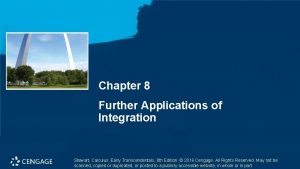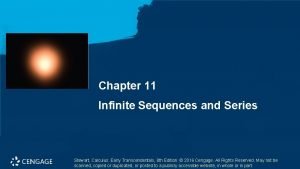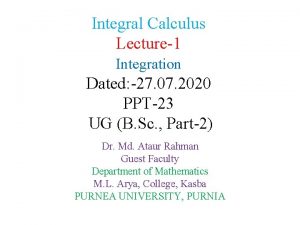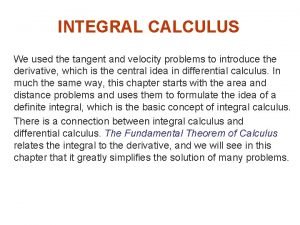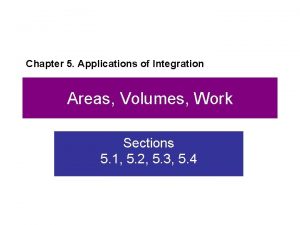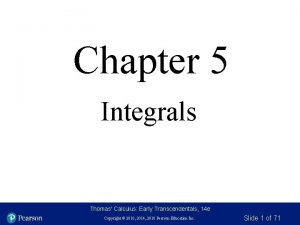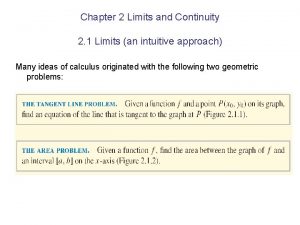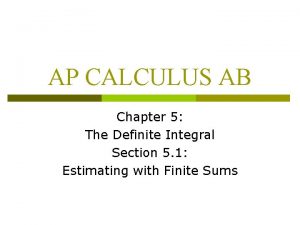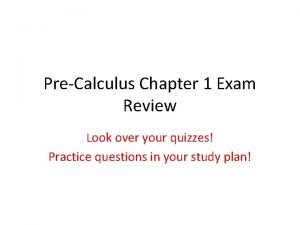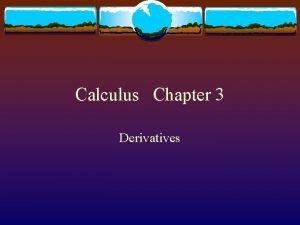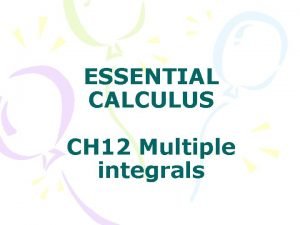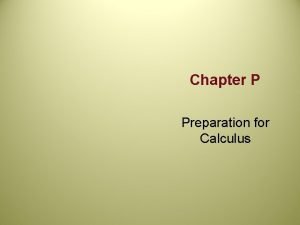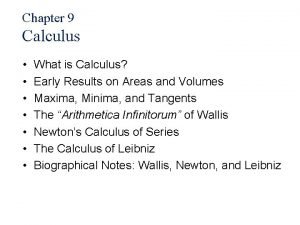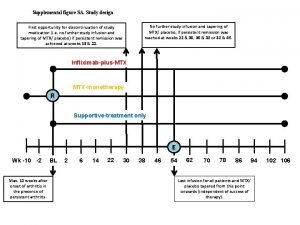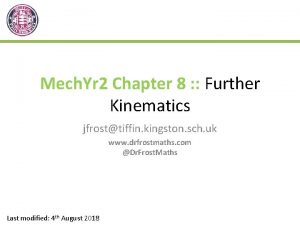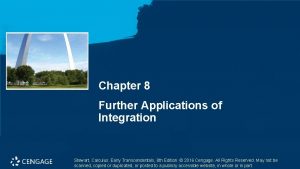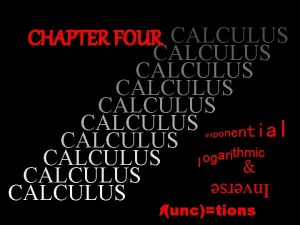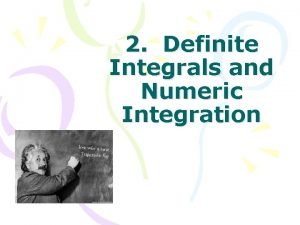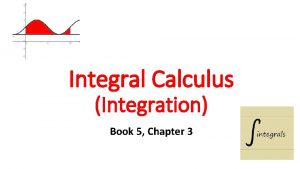Chapter 8 Further Applications of Integration Stewart Calculus
























- Slides: 24

Chapter 8 Further Applications of Integration Stewart, Calculus: Early Transcendentals, 8 th Edition. © 2016 Cengage. All Rights Reserved. May not be scanned, copied or duplicated, or posted to a publicly accessible website, in whole or in part.

8. 2 Area of a Surface of Revolution Stewart, Calculus: Early Transcendentals, 8 th Edition. © 2016 Cengage. All Rights Reserved. May not be scanned, copied or duplicated, or posted to a publicly accessible website, in whole or in part.

Area of a Surface of Revolution (1 of 16) A surface of revolution is formed when a curve is rotated about a line. Such a surface is the lateral boundary of a solid of revolution. We want to define the area of a surface of revolution in such a way that it corresponds to our intuition. If the surface area is A, we can imagine that painting the surface would require the same amount of paint as does a flat region with area A. Stewart, Calculus: Early Transcendentals, 8 th Edition. © 2016 Cengage. All Rights Reserved. May not be scanned, copied or duplicated, or posted to a publicly accessible website, in whole or in part.

Area of a Surface of Revolution (2 of 16) Let’s start with some simple surfaces. The lateral surface area of a circular cylinder with radius r and height h is taken to be A = 2πrh because we can imagine cutting the cylinder and unrolling it (as in Figure 1) to obtain a rectangle with dimensions 2πr and h. Figure 1 Stewart, Calculus: Early Transcendentals, 8 th Edition. © 2016 Cengage. All Rights Reserved. May not be scanned, copied or duplicated, or posted to a publicly accessible website, in whole or in part.

Area of a Surface of Revolution (3 of 16) Likewise, we can take a circular cone with base radius r and slant height l, cut it along the dashed line in Figure 2, and flatten it to form a sector of a circle with radius l and central angle Figure 2 Stewart, Calculus: Early Transcendentals, 8 th Edition. © 2016 Cengage. All Rights Reserved. May not be scanned, copied or duplicated, or posted to a publicly accessible website, in whole or in part.

Area of a Surface of Revolution (4 of 16) We know that, in general, the area of a sector of a circle with radius l and angle θ is and so in this case the area is Therefore we define the lateral surface area of a cone to be A = πrl. What about more complicated surfaces of revolution? If we follow the strategy we used with arc length, we can approximate the original curve by a polygon. Stewart, Calculus: Early Transcendentals, 8 th Edition. © 2016 Cengage. All Rights Reserved. May not be scanned, copied or duplicated, or posted to a publicly accessible website, in whole or in part.

Area of a Surface of Revolution (5 of 16) When this polygon is rotated about an axis, it creates a simpler surface whose surface area approximates the actual surface area. By taking a limit, we can determine the exact surface area. The approximating surface, then, consists of a number of bands, each formed by rotating a line segment about an axis. Stewart, Calculus: Early Transcendentals, 8 th Edition. © 2016 Cengage. All Rights Reserved. May not be scanned, copied or duplicated, or posted to a publicly accessible website, in whole or in part.

Area of a Surface of Revolution (6 of 16) To find the surface area, each of these bands can be considered a portion of a circular cone, as shown in Figure 3 Stewart, Calculus: Early Transcendentals, 8 th Edition. © 2016 Cengage. All Rights Reserved. May not be scanned, copied or duplicated, or posted to a publicly accessible website, in whole or in part.

Area of a Surface of Revolution (7 of 16) The area of the band (or frustum of a cone) with slant height l and upper and lower radii r 1 and r 2 is found by subtracting the areas of two cones: From similar triangles we have which gives Stewart, Calculus: Early Transcendentals, 8 th Edition. © 2016 Cengage. All Rights Reserved. May not be scanned, copied or duplicated, or posted to a publicly accessible website, in whole or in part.

Area of a Surface of Revolution (8 of 16) Putting this in Equation 1, we get or where is the average radius of the band. Stewart, Calculus: Early Transcendentals, 8 th Edition. © 2016 Cengage. All Rights Reserved. May not be scanned, copied or duplicated, or posted to a publicly accessible website, in whole or in part.

Area of a Surface of Revolution (9 of 16) Now we apply this formula to our strategy. Consider the surface shown in Figure 4, which is obtained by rotating the curve y = f (x), a ≤ x ≤ b, about the xaxis, where f is positive and has a continuous derivative. (a) Surface of revolution (b) Approximating band Figure 4 Stewart, Calculus: Early Transcendentals, 8 th Edition. © 2016 Cengage. All Rights Reserved. May not be scanned, copied or duplicated, or posted to a publicly accessible website, in whole or in part.

Area of a Surface of Revolution (10 of 16) In order to define its surface area, we divide the interval [a, b] into n subintervals with endpoints x 0, x 1, . . . , xn and equal width Δx, as we did in determining arc length. If yi = f (xi ), then the point Pi(xi, yi ) lies on the curve. The part of the surface between xi − 1 and xi is approximated by taking the line segment Pi − 1 Pi and rotating it about the x-axis. Stewart, Calculus: Early Transcendentals, 8 th Edition. © 2016 Cengage. All Rights Reserved. May not be scanned, copied or duplicated, or posted to a publicly accessible website, in whole or in part.

Area of a Surface of Revolution (11 of 16) The result is a band with slant height and average radius so, by Formula 2, its surface area is As in the proof, We have where xi is some number in [xi − 1, xi]. Stewart, Calculus: Early Transcendentals, 8 th Edition. © 2016 Cengage. All Rights Reserved. May not be scanned, copied or duplicated, or posted to a publicly accessible website, in whole or in part.

Area of a Surface of Revolution (12 of 16) When Δx is small, we have yi = f(xi) ≈ f(xi ) and also yi − 1 = f(xi − 1) ≈ f(xi ), since f is continuous. Therefore and so an approximation to what we think of as the area of the complete surface of revolution is Stewart, Calculus: Early Transcendentals, 8 th Edition. © 2016 Cengage. All Rights Reserved. May not be scanned, copied or duplicated, or posted to a publicly accessible website, in whole or in part.

Area of a Surface of Revolution (13 of 16) This approximation appears to become better as n ∞ and, recognizing (3) as a Riemann sum for the function we have Therefore, in the case where f is positive and has a continuous derivative, we define the surface area of the surface obtained by rotating the curve y = f (x), a ≤ x ≤ b, about the x-axis as Stewart, Calculus: Early Transcendentals, 8 th Edition. © 2016 Cengage. All Rights Reserved. May not be scanned, copied or duplicated, or posted to a publicly accessible website, in whole or in part.

Area of a Surface of Revolution (14 of 16) With the Leibniz notation for derivatives, this formula becomes If the curve is described as x = g(y), c y d, then the formula for surface area becomes Stewart, Calculus: Early Transcendentals, 8 th Edition. © 2016 Cengage. All Rights Reserved. May not be scanned, copied or duplicated, or posted to a publicly accessible website, in whole or in part.

Area of a Surface of Revolution (15 of 16) Now both Formulas 5 and 6 can be summarized symbolically, using the notation for arc length, as For rotation about the y-axis, the surface area formula becomes where, as before, we can use either Stewart, Calculus: Early Transcendentals, 8 th Edition. © 2016 Cengage. All Rights Reserved. May not be scanned, copied or duplicated, or posted to a publicly accessible website, in whole or in part.

Area of a Surface of Revolution (16 of 16) These formulas can be remembered by thinking of 2πy or 2πx as the circumference of a circle traced out by the point (x, y) on the curve as it is rotated about the x-axis or y-axis, respectively (see Figure 5). Figure 4 Stewart, Calculus: Early Transcendentals, 8 th Edition. © 2016 Cengage. All Rights Reserved. May not be scanned, copied or duplicated, or posted to a publicly accessible website, in whole or in part.

Example 1 The curve is an arc of the circle Find the area of the surface obtained by rotating this arc about the x-axis. (The surface is a portion of a sphere of radius 2. See Figure 6. ) Figure 6 Stewart, Calculus: Early Transcendentals, 8 th Edition. © 2016 Cengage. All Rights Reserved. May not be scanned, copied or duplicated, or posted to a publicly accessible website, in whole or in part.

Example 1 – Solution (1 of 2) We have and so, by Formula 5, the surface area is Stewart, Calculus: Early Transcendentals, 8 th Edition. © 2016 Cengage. All Rights Reserved. May not be scanned, copied or duplicated, or posted to a publicly accessible website, in whole or in part.

Example 1 – Solution (2 of 2) Stewart, Calculus: Early Transcendentals, 8 th Edition. © 2016 Cengage. All Rights Reserved. May not be scanned, copied or duplicated, or posted to a publicly accessible website, in whole or in part.

Example 3 Find the area of the surface generated by rotating the curve about the x-axis. Solution: Using Formula 5 with we have Stewart, Calculus: Early Transcendentals, 8 th Edition. © 2016 Cengage. All Rights Reserved. May not be scanned, copied or duplicated, or posted to a publicly accessible website, in whole or in part.

Example 3 – Solution (1 of 2) Stewart, Calculus: Early Transcendentals, 8 th Edition. © 2016 Cengage. All Rights Reserved. May not be scanned, copied or duplicated, or posted to a publicly accessible website, in whole or in part.

Example 3 – Solution (2 of 2) Since tanα = e, we have Stewart, Calculus: Early Transcendentals, 8 th Edition. © 2016 Cengage. All Rights Reserved. May not be scanned, copied or duplicated, or posted to a publicly accessible website, in whole or in part.
 Further applications of integration
Further applications of integration Further applications of integration
Further applications of integration Further applications of integration
Further applications of integration Further applications of integration
Further applications of integration Further applications of integration
Further applications of integration Further applications of integration
Further applications of integration Integration of power series
Integration of power series Integral
Integral Indefinite integration formulas
Indefinite integration formulas Integration area and volume
Integration area and volume Forward integration and backward integration
Forward integration and backward integration Forward integration and backward integration
Forward integration and backward integration Example of simultaneous integration
Example of simultaneous integration Calculus chapter 5 integrals
Calculus chapter 5 integrals Calculus chapter 2 limits and continuity answers
Calculus chapter 2 limits and continuity answers Ap calc ab chapter 5
Ap calc ab chapter 5 Precalculus chapter 1
Precalculus chapter 1 Calculus chapter 3
Calculus chapter 3 Calculus chapter 12
Calculus chapter 12 Chapter p preparation for calculus
Chapter p preparation for calculus Calculus chapter 9
Calculus chapter 9 Cohesion
Cohesion Further study design
Further study design On a ship, its corresponds to a floor in a building *
On a ship, its corresponds to a floor in a building * Dr frost further kinematics
Dr frost further kinematics




